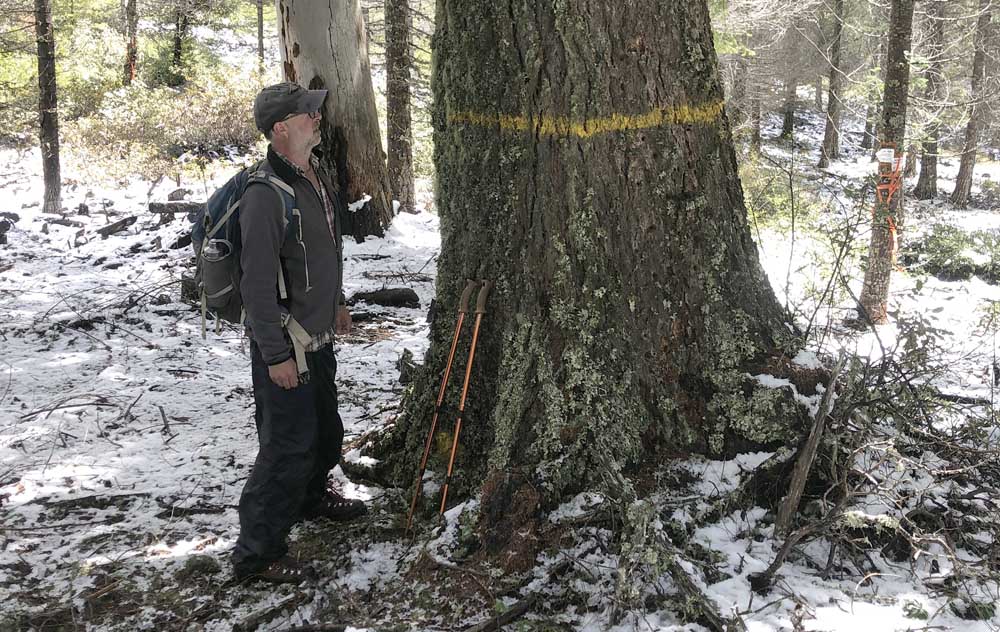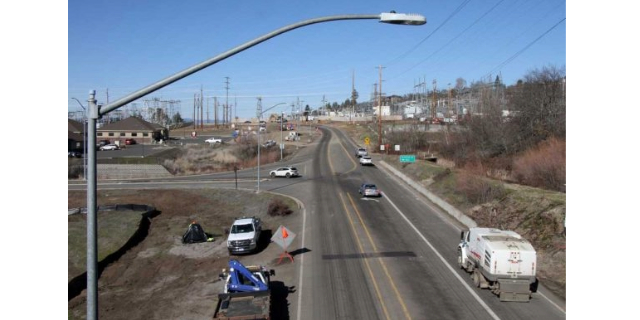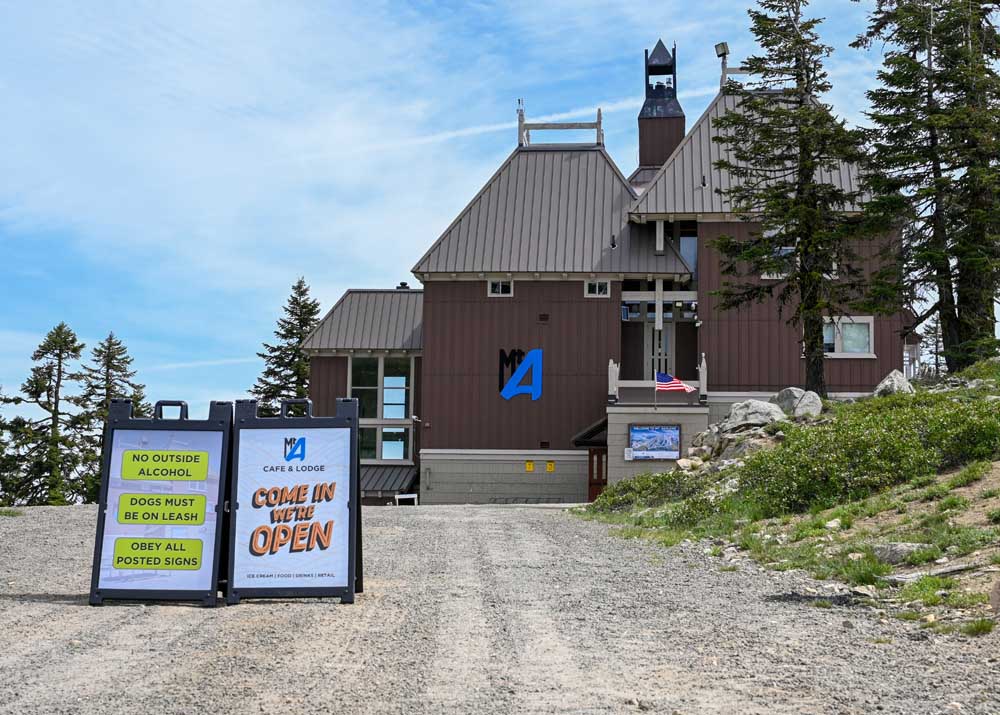Judges nixes BLM effort to reduce fire risk by logging protected reserves
Published 2:30 pm Friday, May 31, 2024

- George Sexton, conservation director at the Klamath-Siskiyou Wildlands Center in Ashland, stands next to a tree he said was originally marked to be saved as a wildlife tree, but later slated to be logged to make way for a road as part of the Late Mungers project near Williams. The project, proposed by the U.S. Bureau of Land Management, is an effort to reduce wildfire danger and improve forest health, but a federal judge last week ruled against the agency's plan to log large trees in protected reserves.
A federal judge in Medford has ruled that a U.S. Bureau of Land Management plan to log protected forest reserves in the name of fire prevention doesn’t pass muster with the law.
Trending
In a 36-page opinion tinged with worry about wildfire danger, U.S. District Court Magistrate Judge Mark D. Clarke rebuked the BLM for a multitude of faults and pointed out that the agency’s plan might actually increase fire danger.
“Of the fifty communities in Oregon identified as ‘the highest cumulative wildfire risk,’ nearly half are located in southwestern Oregon,” Clarke wrote in a ruling last week. “There has never been a higher need for proactive land planning solutions that are founded on reliable research and dedicated to preserving this area’s homes, communities and natural resources.”
Clarke’s ruling leaves the door open for the BLM to conduct logging using a lighter touch.
Trending
Conservation groups had sued the agency over its Integrated Vegetation Management for Resilient Lands Program, which seeks to speed logging and promote the use of low-intensity fire. The logging would create openings that could hamper the spread of fire and reduce competition between trees while the use of low-intensity fire could reduce woody debris on the forest floor that could fuel flames.
But the program would permit logging that would take away trees accounting for up to 70% to 80% of forest canopy within targeted areas in reserves, which Clarke ruled would violate BLM’s own management plan in Southwest Oregon. The reserves, known as late-successional reserves, were created under the 30-year-old Northwest Forest Plan, in order to protect habitat for the threatened northern spotted owl. Out of 1.2 million acres managed by the BLM in its Medford, Roseburg and Lakeview districts, 381,158 acres, or about 32%, are set aside as reserves.
The BLM introduced its IVM program five years ago in Southwest Oregon and used it last year in an effort to speed logging and conduct fuels reduction work in the name of fire resilience and forest health. The program relied on an already completed environmental assessment applicable across most of the Medford District.
The program would allow the commercial logging of trees up to 36 inches in diameter and 173 years old on 17,000 acres in reserves per decade. Conservation groups sued last year after the agency proposed to commercially log 830 acres within reserves located in the mountains between Williams and Murphy in Josephine County. The logging would have taken place under the name Late Mungers project and operate under the IVM program, marking the first time that commercial logging would take place in reserves under the program.
As part of the Late Mungers project, the BLM also proposed to log trees 8 inches and less in diameter and conduct prescribed burns on an additional 7,534 acres. Now that Clarke’s order halts the commercial logging in reserves, it’s unclear whether that small-diameter logging and prescribed fire will take place.
BLM spokesman Kyle Sullivan was noncommittal on where things might go from here.
“We are reviewing the decision and determining next steps,” Sullivan said Wednesday.
The conservation groups bringing the action include the Klamath-Siskiyou Wildlands Center, the Soda Mountain Wilderness Council and the Applegate Siskiyou Alliance, along with Cascadia Wildlands and Oregon Wild. They argued that the BLM failed to comply with its 2016 resource management plan and failed to take a hard look at impacts from the IVM program. The agency argued that it met all its obligations, including obligations under federal environmental law. Supporting the BLM in the litigation are the American Forest Resource Council and the Association of O&C Counties.
In particular, the conservation organizations argued that the BLM failed to ensure that the IVM program complied with what is known as a 20-year standard, while the agency argued that the standard didn’t apply. Under the agency’s overarching 2016 resource management plan, logging in reserves is allowed if it meets what is known as a 20-year standard.
“Under that guidance, BLM is clearly permitted — at times even obligated — to conduct distinct fire management treatments in LSRs (reserves), even if they downgrade or remove habitat, so long as those treatments are limited in actions that do not preclude or delay future habitat development by 20 years or more,” Clarke wrote. “BLM is even permitted to commercially log in LSRs, provided it complies with the 20-year standard.”
However, Clarke found that the agency’s actions could degrade spotted owl habitat beyond 20 years, to as much as 50 years. He also noted that the BLM’s logging could increase fire hazards by creating open areas in the forest that would be replaced with highly flammable new growth, and that the clearings could increase surface wind gusts and temperatures, thus increasing the severity of surface fire behavior.
The BLM argued that the open areas could help slow the spread of fire and could improve forest health by reducing competition between trees.
Most of the conservation organizations sought only to stop the commercial logging in reserves while allowing small-diameter logging and prescribed fire treatments to continue, although the Siskiyou Applegate Alliance wanted the entire IVM program halted. Clarke put his ruling on hold for 30 days to give the parties time to arrive at an appropriate remedy. His ultimate ruling must be ratified by Senior U.S. District Court Judge Ann Aiken.
“Plaintiffs acknowledge that BLM’s plans include proactive and admirable strategies directed across many high-risk areas,” Clarke wrote. “Given the mutual affection for Oregon’s forests shared by all in this action, the Court is confident that dedicated collaboration will result in an effective solution.”
“The Court further strongly encourages the parties to work collaboratively to see if the noncontroversial parts of this important forest management project can move forward without significant delay.”
Nick Smith, public affairs director for the American Forest Resource Council, stood by the BLM and hoped Aiken would reverse Clarke’s decision.
“We continue to believe this project is incredibly important given the risk of fire to these dry forests,” Smith said, in a telephone interview Wednesday. “IVM represents a very major effort on the part of the BLM to restore the health of these forests.”
“We’re willing to work collaboratively to move pieces of these projects forward,” he added.
KS Wild released a statement on Wednesday about the decision.
“The BLM once again put its logging agenda above collaboration, fire resiliency and wildlife habitat and the court held them to account for ignoring science, the law and the public …,” said George Sexton, KS Wild conservation director.
The parties had argued their case April 2 before Clarke at the federal courthouse in Medford, following a demonstration outside by about 35 people opposed to the BLM’s IVM program, which would allow for commercial logging of up to 4,000 acres a year, small-diameter thinning of up to 6,500 acres a year and prescribed fire on up to 7,500 acres a year across the BLM’s Medford district.
In his ruling, Clarke wrote that the agency’s plan, if approved, “would have sweeping impacts” that “would severely undercut the ability of (the BLM) to protect and promote habitat decades into the future.”
The case, he wrote, “arises out of an extraordinarily delicate situation and presents a unique opportunity to address a solution that will impact hundreds of thousands of acres of high-risk lands. In this regard, the Court echoes KS Plaintiffs’ sentiment: ‘Getting this project right could benefit southwestern Oregon for years to come, while getting it wrong may have devastating consequences across the landscape for fire behavior and wildlife habitat.’”









